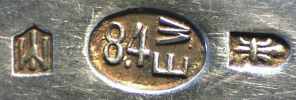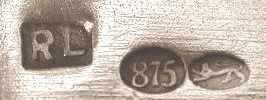EUROPEAN COUNTRIES SILVER AND GOLD HALLMARKS
ESTONIA
A silver or gold object that is to be sold commercially is, in most countries, stamped with one or more hallmarks indicating the purity of the metal and the mark of the manufacturer or silversmith
The word "HALLMARK" derives from the fact that, since the 16th century, precious metals were sent to the London Goldsmiths' Hall for testing to ensure that the correct standard of silver had been used. The Goldsmiths' Hall was the headquarters of the Goldsmiths' Company and the home of the Assay Office.
In some countries, the testing of precious metal objects and marking of purity is controlled by a national assay office.
Depending on the national legislation the use of hallmarks may be compulsory, voluntary or provided by a manufacturer's declaration.
The Estonian hallmarking system is organized on a voluntary base.
Russian hallmarks were used from 1840 to 1918 and from 1946 to 1990

In the period 1919-1924 was used a re-hallmarking mark "EW + flower" (Eesti Wabariik/Estonian Republic). Silver content was expressed in zolotniki (84)
The lion moving left mark into an oval together with silver content (800, 875, 900 and 935) was introduced in 1922 and was in use until 1940.
A similar mark was reinstated after independence from Soviet Union (1990).
 1 1
 2 2
 3 3
 4 4
 5 5
 6 6
1: re-hallmarking mark 1919-1924 2: re-hallmarking mark 1919-1924 3: Russian/Estonian mark - unidentified Moscow silversmith and Joseph Kopf (Tallinn) 4: Hirsch Markowitsch (Tallinn) 5: Richard Lange 6: Theodor Grühn (Tallinn)
Soviet Union (SSSR) mark used 1963-1968, 875/1000 silver fineness, town of Tallinn (now Estonia)

|
palladium

|
The present Estonia hallmarking system is based on:
- two mandatory marks: maker's mark and silver fineness
- two optional marks: control mark (lion facing left) and date letter
|

|

www.silvercollection.it |
This is a page of 'The What is? Silver Dictionary' of A Small Collection of
Antique Silver and Objects of vertu, a 1500 pages richly illustrated website offering all you need to know about
antique silver, sterling silver, silverplate, Sheffield plate, electroplate silver,
silverware, flatware, tea services and tea complements, marks and hallmarks, articles,
books, auction catalogs, famous silversmiths (Tiffany, Gorham, Jensen, Elkington),
history, oddities ...
HOME - SITE MAP - SILVER DICTIONARY - COOKIES CONSENT AND PRIVACY |
| |